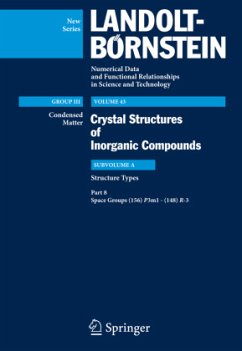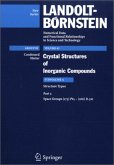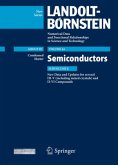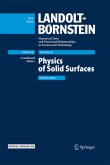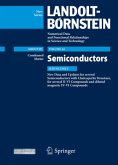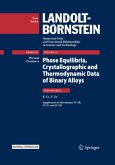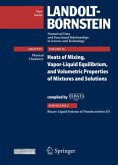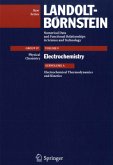Pierre Villars (Hrsg.)
Space groups (156) P3m1-(148) R-3 / Landolt-Börnstein, Numerical Data and Functional Relationships in Science and Technology BD 3
Herausgegeben:Villars, Pierre
Pierre Villars (Hrsg.)
Space groups (156) P3m1-(148) R-3 / Landolt-Börnstein, Numerical Data and Functional Relationships in Science and Technology BD 3
Herausgegeben:Villars, Pierre
- Gebundenes Buch
- Merkliste
- Auf die Merkliste
- Bewerten Bewerten
- Teilen
- Produkt teilen
- Produkterinnerung
- Produkterinnerung
In the 1970s Landolt-Börnstein published a series of volumes containing crystallographic data for organic (III/5 Str- ture Data of Organic Crystals), intermetallic (III/6 Structure Data of Elements and Intermetallic phases) and inorganic compounds (III/7 Crystal Structure Data of Inorganic Compounds). During the 30 years that have passed, the expe- mental methods leading to a complete structure determination have considerably improved and the large number of cr- tal structures known today justi?es the publication of a new compilation. The present volume will cover both intermetallic and…mehr
Andere Kunden interessierten sich auch für
![Space groups (173) P63 - (166) R-3m / Landolt-Börnstein, Numerical Data and Functional Relationships in Science and Technology Vol.43a/5 Space groups (173) P63 - (166) R-3m / Landolt-Börnstein, Numerical Data and Functional Relationships in Science and Technology Vol.43a/5]() Space groups (173) P63 - (166) R-3m / Landolt-Börnstein, Numerical Data and Functional Relationships in Science and Technology Vol.43a/5373,99 €
Space groups (173) P63 - (166) R-3m / Landolt-Börnstein, Numerical Data and Functional Relationships in Science and Technology Vol.43a/5373,99 €![Semiconductors / Landolt-Börnstein, Numerical Data and Functional Relationships in Science and Technology 44E, Subvol.E Semiconductors / Landolt-Börnstein, Numerical Data and Functional Relationships in Science and Technology 44E, Subvol.E]() Semiconductors / Landolt-Börnstein, Numerical Data and Functional Relationships in Science and Technology 44E, Subvol.E371,99 €
Semiconductors / Landolt-Börnstein, Numerical Data and Functional Relationships in Science and Technology 44E, Subvol.E371,99 €![Physics of Solid Surfaces / Landolt-Börnstein, Numerical Data and Functional Relationships in Science and Technology 45A Physics of Solid Surfaces / Landolt-Börnstein, Numerical Data and Functional Relationships in Science and Technology 45A]() G. BenedekPhysics of Solid Surfaces / Landolt-Börnstein, Numerical Data and Functional Relationships in Science and Technology 45A373,99 €
G. BenedekPhysics of Solid Surfaces / Landolt-Börnstein, Numerical Data and Functional Relationships in Science and Technology 45A373,99 €![New Data and Updates for several Semiconductors with Chalcopyrite Structure, for several II-VI Compounds and diluted mag / Landolt-Börnstein, Numerical Data and Functional Relationships in Science and Technology Vol.44F New Data and Updates for several Semiconductors with Chalcopyrite Structure, for several II-VI Compounds and diluted mag / Landolt-Börnstein, Numerical Data and Functional Relationships in Science and Technology Vol.44F]() Dieter StrauchNew Data and Updates for several Semiconductors with Chalcopyrite Structure, for several II-VI Compounds and diluted mag / Landolt-Börnstein, Numerical Data and Functional Relationships in Science and Technology Vol.44F371,99 €
Dieter StrauchNew Data and Updates for several Semiconductors with Chalcopyrite Structure, for several II-VI Compounds and diluted mag / Landolt-Börnstein, Numerical Data and Functional Relationships in Science and Technology Vol.44F371,99 €![Phase Equilibria, Crystallographic and Thermodynamic Data of Binary Alloys / Landolt-Börnstein, Numerical Data and Functional Relationships in Science and Technology 12/D Phase Equilibria, Crystallographic and Thermodynamic Data of Binary Alloys / Landolt-Börnstein, Numerical Data and Functional Relationships in Science and Technology 12/D]() Felicitas PredelPhase Equilibria, Crystallographic and Thermodynamic Data of Binary Alloys / Landolt-Börnstein, Numerical Data and Functional Relationships in Science and Technology 12/D371,99 €
Felicitas PredelPhase Equilibria, Crystallographic and Thermodynamic Data of Binary Alloys / Landolt-Börnstein, Numerical Data and Functional Relationships in Science and Technology 12/D371,99 €![Binary Liquid Systems of Nonelectrolytes III / Landolt-Börnstein, Numerical Data and Functional Relationships in Science and Technology 26C Binary Liquid Systems of Nonelectrolytes III / Landolt-Börnstein, Numerical Data and Functional Relationships in Science and Technology 26C]() Binary Liquid Systems of Nonelectrolytes III / Landolt-Börnstein, Numerical Data and Functional Relationships in Science and Technology 26C371,99 €
Binary Liquid Systems of Nonelectrolytes III / Landolt-Börnstein, Numerical Data and Functional Relationships in Science and Technology 26C371,99 €![Electrochemical Thermodynamics and Kinetics / Landolt-Börnstein, Numerical Data and Functional Relationships in Science and Technology 9A Electrochemical Thermodynamics and Kinetics / Landolt-Börnstein, Numerical Data and Functional Relationships in Science and Technology 9A]() Rudolf HolzeElectrochemical Thermodynamics and Kinetics / Landolt-Börnstein, Numerical Data and Functional Relationships in Science and Technology 9A373,99 €
Rudolf HolzeElectrochemical Thermodynamics and Kinetics / Landolt-Börnstein, Numerical Data and Functional Relationships in Science and Technology 9A373,99 €-
-
-
In the 1970s Landolt-Börnstein published a series of volumes containing crystallographic data for organic (III/5 Str- ture Data of Organic Crystals), intermetallic (III/6 Structure Data of Elements and Intermetallic phases) and inorganic compounds (III/7 Crystal Structure Data of Inorganic Compounds). During the 30 years that have passed, the expe- mental methods leading to a complete structure determination have considerably improved and the large number of cr- tal structures known today justi?es the publication of a new compilation. The present volume will cover both intermetallic and classical inorganic compounds, a clear limit having been drawn by excluding compounds that contain C-H bonds. Whereas the earlier edition listed space group/crystal system and cell parameters for different classes of compounds, we have here chosen a different approach by grouping known crystal structures into structure types. The structure type concept is widely used among inorganic compounds, where then- ber of isotypic compounds can reach several hundreds. The ?rst subvolumes will contain complete crystallographic data sets, including atom coordinates, that represent distinct structure types, whereas the last subvolumes will list cell pa- meters of isotypic compounds. The crystallographic data are accompanied by remarks and crystallographic features common to isotypic compounds, such as the atomic environments, a brief description of the main structural features, and drawings of selected structure types.
Produktdetails
- Produktdetails
- Landolt-Börnstein: Numerical Data and Functional Relationships in Science and Technology - New Series 4
- Verlag: Springer / Springer Berlin Heidelberg / Springer, Berlin
- Artikelnr. des Verlages: 978-3-540-70891-9
- Seitenzahl: 530
- Englisch
- Abmessung: 34mm x 202mm x 277mm
- Gewicht: 1417g
- ISBN-13: 9783540708919
- ISBN-10: 354070891X
- Artikelnr.: 26873865
- Herstellerkennzeichnung Die Herstellerinformationen sind derzeit nicht verfügbar.
- Landolt-Börnstein: Numerical Data and Functional Relationships in Science and Technology - New Series 4
- Verlag: Springer / Springer Berlin Heidelberg / Springer, Berlin
- Artikelnr. des Verlages: 978-3-540-70891-9
- Seitenzahl: 530
- Englisch
- Abmessung: 34mm x 202mm x 277mm
- Gewicht: 1417g
- ISBN-13: 9783540708919
- ISBN-10: 354070891X
- Artikelnr.: 26873865
- Herstellerkennzeichnung Die Herstellerinformationen sind derzeit nicht verfügbar.
Structure type index by space group.- Alphabetical index of substances.- ZnS 16H1.- ZnS 16H2.- ZnS 16H3.- TiS1.7 16H.- AgI 16H.- PbI2 22H.- CdI2 22H1.- CdI2 22H2.- CdI2 22H3.- CdI2 22H4.- CdI2 22H6.- CdI2 22H7.- CdI2 22H8.- CdI2 22H9.- CdI2 22H10.- CdI2 22H11.- CdI2 22H12.- CdI2 22H13.- ZnS 18H8.- ZnS 18H1.- ZnS 18H3.- ZnS 18H2.- ZnS 18H4.- ZnS 18H5.- ZnS 18H6.- ZnS 18H7.- PbI2 24H1.- CdI2 24H2.- CdI2 24H3.- CdI2 24H4.- CdI2 24H5.- CdI2 24H6.- CdI2 24H7.- CdI2 24H8.- CdI2 24H9.- CdI2 24H10.- CdI2 24H11.- CdI2 24H12.- CdI2 24H13.- SiC 19H.- CdI2 26H1.- CdI2 26H2.- CdI2 26H3.- CdI2 26H4.- CdI2 26H5.- CdI2 26H6.- ZnS 20H2.- ZnS 20H1.- ZnS 20H3.- ZnS 20H4.- ZnS 20H5.- ZnS 20H7.- ZnS 20H8.- ZnS 20H9.- ZnS 20H10.- SiC 21H.- CdI2 28H1.- CdI2 28H2.- CdI2 28H3.- CdI2 28H4.- CdI2 28H5.- CdI2 28H6.- CdI2 28H7.- CdI2 28H8.- ZnS 22H3.- ZnS 22H1.- ZnS 22H2.- PbI2 30H1.- CdI2 30H1.- CdI2 30H2.- CdI2 30H3.- CdI2 30H4.- CdI2 30H5.- CdI2 30H6.- CdI2 30H7.- ZnS 24T1.- ZnS 24H4.- ZnS 24H5.- ZnS 24H7.- ZnS24H8.- ZnS 24H10.- ZnS 24H14.- ZnS 24T2.- ZnS 24H3.- ZnS 24H6.- ZnS 24H9.- ZnS 24H11.- ZnS 24H12.- ZnS 24H13.- CdI2 32H1.- CdI2 32H2.- CdI2 32H3.- CdI2 34H1.- CdI2 34H4.- CdI2 34H5.- CdI2 34H6.- ZnS 26H5.- ZnS 26H1.- ZnS 26H2.- ZnS 26H3.- ZnS 26H4.- Ba6Fe3Si8O23(CO3)2(Cl,OH)3?H2O.- SiC 27H.- CdI2 36H1.- CdI2 36H2.- CdI2 36H3.- ZnS 28H1.- ZnS 28H2.- ZnS 28H3.- ZnS 28H4.- ZnS 28H5.- ZnS 28H6.- ZnS 28H7.- CdI2 38H1.- CdI2 38H2.- CdI2 40H1.- CdI2 40H2.- CdI2 40H3.- Ca4Cr7Al51.- CdI2 42H1.- CdI2 42H2.- ZnS 32H1.- ZnS 32H2.- CdI2 44H1.- ZnS 34H.- ZnS 36H2.- SiC 36H.- ZnS 36H1.- Cu1.81Te ?III.- Cu1-xAg1-yTe.- Na2S2O3 ?.- CdI2 50H1.- ZnS 40H.- CdI2 58H1.- ZnS 44H1.- ZnS 44H2.- Pb2Nb2O7.- ZnS 64H.- Sc2B1.1C3.2.- ScF3 rt.- Ni3S2 ?.- (Cr,Mo)2O3.- Au5Sn.- Ag3BO3 form I.- AlF3 ?.- BaH3IO6.- KBe2BO3F2.- BaMg(CO3)2.- Lu2(CN2)3.- BaAl2B2O7.- RbTl(SO4)2.- NH4Ni(PO3)3.- (NH4)4RhCl6NO3 rt.- Na2Ca3Ta2O9.- Zr3O.- K1.3(H3O)0.7ZrSi3O9?1.5H2O.- (Ca,Na)0.67ZrSi3O9(H2O,H3O)3.- K3Y(NH2)6.- CaMg3(CO3)4.- Zn6-xSb5 lt.- Mg3Hg.- Zn8(BO3)3O2(OH)3.- Ba6Ni5O15.- K4Gd2(CO3)3F4.- ErNi3Al9.- SnAsF7.- Ba6Mn4ZnO15.- (H3O)3(UO2)3O(OH)3(SeO4)2.- Ba6Mn4CuO15.- GdBO3 rt.- DyNi3Al9.- Al7Te10.- Sb1.50Fe0.50(PO4)3.- BaZrSi3O9?2.4H2O.- CaGa6Te10.- NaGa3Te5.- Li2Ga6Te10 rt.- Na2ZrSi3O9?3H2O.- K0.67Ag0.33Nb2PO8.- Na2(Na2.4K0.6)(Zr0.7Ti0.2Nb0.1)(Y0.8REE0.2)Si6O18?6H2O.- Nd(O2SN)3?6H2O.- Na0.5(H3O)0.5Nb2PO8.- Ca0.5Cs2Nb6P3O24.- K0.67Li0.33Nb2PO8.- NaAgGa6Te10.- Na2InGa5Se10.- (NH4)6MnMo9O32?8H2O.- Na5Ti(PO4)3.- Na5Zr(PO4)3.- Na5.5ZrSi0.5P2.5O12 rt.- Tl1-xNaxNb2PO8.- K6Na2.- Na6Nb8P5O35.- K3Na3Nb8P5O35.- Na2B4O5(OH)4?3H2O.- RbAg4I5 ?.- Ca2Fe22O33.- Sn21Cl16(OH)14O6.- Na2B4O5(OH)4?2.67H2O.- (NH4)6MnMo9O32?6H2O.- Ag4Mn3O8 ?.- Ba12Rh9.25Ir1.75O33 12R.- (NH4)6NiMo9O32?6H2O.- Na4Mo10O32?8H2O.- K3Na3MnMo9O32?6H2O.- Ca3.0Fe14.82O25 ?.- Sr6Rh5O15.- Na5LuSi4O12.- (Ba,K,Na,Ca)11-12(REE,Fe,Th)4(Ti,Nb)6(Si6O18)4(OH)12?4.5H2O.- (Ba,Na)10K3Na4.5Ce5(Nb,Ti)6.- Se trigonal.- Sm form V.- HgS ?.- CdTe hp1.- Pr form III.- S helical.- SiO2 ?-quartz.- N2H4?H2O trigonal.- BaZnO2.- TlNO2 form II.- SrHgO2.- B2O3 form I.- EuIr2P2.- IrGe4.- BiPO4 hexagonal.- AgPO2(NH2)2.- AlAsO4.- AgN(CN)2 trigonal.- Sr2CuO2Cl.- CaSO4?0.5H2O.- (La,Ce)BSiO5 ht.- TlSrLa(AsO4)2.- BiPO4?0.67H2O.- CaCO3?H2O.- RbAg2SbS4.- NdBSiO5.- Na3OsO5.- Hg3O2SO4.- Ca(NCS)2?4H2O.- [Zn(NH3)4](I3)2.- NaCe(SO4)2?H2O.- CaSO4?0.5H2O.- RbBa2As5.- Li2Ta2O3F6.- Hg3O2CrO4.- NaLa(SO4)2?H2O.- K2HCr2AsO10 form I.- Fe7Se8 3c.- Fe7S8 3c.- K8(H3O)(Tc2Cl8)3?3H2O.- (NH4)3Tc2Cl8?2H2O.- LaAl3Br12.- MnBPO4(OH)2.- CaCd(NO2)4?4H2O.- [Xe2F3]AsF6 trigonal.- GdFe3(BO3)4 lt.- Ni13Ga3Ge6.- Mn2Sb2O7.- Na2MnCrF7.- (H3O).- (Ca,Na,REE,Th)2Zr2(Ti,Nb,Ta)3(Fe,Ti)O14.- Na2MnFeF7.- Cs2Al(NO3)5.- BaMo2O4(C2O4)2?5H2O.- Ca0.8Ti1.35Zr1.3Th0.15Al0.4O7 3T.- H[cis-Fe(H2O)2]Re6Se8(CN)6?2H2O.- Na2Ca2Si3O9 rt.- Na2Ca2Si3O9 rt.- SnAl6Te10.- Ni17S18.- Na2.54Ca1.73Ge3O9.- (CuI)3Cu2TeS3.- Os5(CO)16.- Co6(C2)(CO)18 trigonal.- RbAg4I5 ?.- K3Rh(C2O4)3?2H2O ?.- Ag4Mn3O8 ?.- K2Na2(H2O)4SiW12O40?4H2O.- K2(H2O)4H2SiMo12O40?7H2O.- K2Na3GaW12O40?9.3H2O ?.- Ba21Ge2O5H24.- NaGaSn5.- Ag2HPO4.- CrCl3 rt.- AlCl3.- V6C5.- Li5ReO6.- LuNi4.- DyAl3Cl12.- KAl3Si3O10(OH)2.- KMg3AlSi3O10(OH,F)2 trigonal.- Cs1.5(H3O)0.5CdZr(C2O4)4?6.8H2O.- La2O3 form A.- Be2BO3OH?H2O 1T.- SrCl2?6H2O.- Fe2P.- Na2ThF6 ?2.- (H3O)2TiF6.- Hg2NHBr2.- Cs2TeO3.- KAl(SO4)2.- AlF3 ?.- Cs3As2Cl9.- LaNi5H6.0.- LaNi4AlH4.1.- Al(IO3)2NO3?6H2O.- Na1.8Ca1.1Si6O14 hp.- Pb3Zn3TeAs2O14.- Ca3Ga2Ge4O14.- La3Nb0.5Ga5.5O14.- La3Ga5SiO14.- MnSb2O6.- LiMnGaF6.- Na2SiF6.- La3Zr0.5Ga5Si0.5O14.- La3Nb0.5Ga5.5O14 hp.- K2S2O6.- Cs2Pt(SO3F)6.- BaSm5Al3Si9N20O.- K2Ga2O(BO3)2.- [Zn(H2O)6](Hg2)3(OH)2(NO3)6.- K2Al2B2O7.- BaGe4O9.- Ni31Si12.- Ca3.0Fe14.82O25 ?.- Sr4Mn2CoO9.- Sr12Ni7.5O27.- NaBa4Cu0.5Pt1.5O8.- Sr12NaNi7O23.- Ba15Pt6O27.- LaNb7O19.- Sr4CuIr2O9.- Ba4(BaxPt1-x)Pt2O9.- Sr4Mn2NiO9.- Sr4Ni3O9.- MoAl5 form h'.- (Ce,Gd)Sc3(BO3)4.- Sr4Mn2CuO9.- (K0.5Na0.5)2Al2B2O7.- Na3ZnTh6F29.- (Ca,Sr)3Al7.7Si3P4O23.5(OH)14.1?8H2O.- (Ag,Cu)16Sb2S11.- (NH4)14Al14Si14O56?xH2O Linde Q.- K7Na7Be14P14O56?20H2O form H.- Ba14Pd3Ir8O33.- Ba16Cu3Ir10O39.- (Na,K)30Ca10Al30Si30O120(SO4)10?2H2O.- [La(H2O)6]3[W3S7(C2O4)3]4Br?xH2O.- [Ce(H2O)6]3[W3S7(C2O4)3]4Br?xH2O.- Fe2N.- KNiIO6.- Pb1.5(BO2.25)2.- ZrO0.4H0.1.- KCoAu3(CN)6.- BaGeTeO6.- ZrO0.4H0.1.- FeCr7S12 form I.- Ti3O ordered.- S6.- WCl6 ?.- KAsF6.- LiSbF6.- PdF3.- Si form XII.- BiI3 3R.- (NH4)2H3IO6.- K2Sn(OH)6.- K2Sn(NH2)6.- (NH4)SnF3.- FeTiO3.- FePSe3.- BaBiO3 ht1.- Ba2YbBiO6.- Cr2S3 rhombohedral.- NiTi3S6.- CaMg(CO3)2.- ZnPSe3.- Na2Mg(CO3)2.- Co(ClO4)2.- Rh3Se8.- Na3GdCl6 form I.- Cr2S3 rhombohedral.- Zr(HPO4)2?0.5H2O ? ht.- Ca2Al(OH)6I?2H2O.- KSbP2O8.- Ir0.58Se1.68.- AlF3?9H2O.- Li6TeO6.- O2AuF6 ht.- BaNi2(AsO4)2.- Pu3Pd4.- NiSnCl6?6H2O.- CsUOF5.- Pb2MgWxTe1-xO6 lt.- He?(6+x)H2O.- Mo6S6Br2.- Mo3Se4.- NiTiO3 rt.- NaNiAsO4.- Ca6Cr2N6H.- PbxMo3S4 rt.- Er3Ni2.- Li8SnO6.- CdPS3 lt.- Li6Ca2Mn2N6.- NH4H3Cu2Mo2O10.- SnMo6S7.9O0.1.- Pd15P2.- AuTa14S2.- La2Ca2MnO7.- Cs8Tl8O.- (NH4)3H(SeO4)2 form II.- K2Te(IO3)2(OH)6.- Mg(SO3CF3)2.- Tl2AgI3.- ZrCo3B2.- Cs2LiMn3F12.- KAu(CN)2.- AuClO.- Pd6Cl12.- Zr6Cl12.- N3S3F3.- La4Ti3O12 12R.- Sc7Cl12.- Zr6CI12.- Pr7O12.- Y6UO12.- NH4.- Ca2Al(OH)6(SO4)0.5?3H2O.- AgBiP2Se6.- CaMn7O12.- Sc7NCl12.- (Ca0.65Pr0.35)Pr6CoI12.- Ge2(H2PO2)6.- [Co(NH3)6][Cr(CN)6].- [Co(NH3)6][Co(CN)6].- CoSiF6?6H2O.- Mg3TeO6.- CsEr6CI12.- InMo6SexS8-x.- Mo7.18S8.- H8Si8O12.- Ti2Nb6O12.- Sb(N3)3.- Ca2Al(OH)6(SO4)0.5?3H2O.- Pb6CrCl6(OH)6(O,OH)2.- Ce7O12.- Y5U2O13.3.- SnFe0.4Mo6S8.- SrB12H12?8H2O.- CaMg2Cl6?12H2O.- Ba2Ca(B3O6)2.- Sr3(B3S6)2.- Re3I6(CO)6.- CuBiP2Se6 lt2.- Dy2FeMoO7.- KTe3O6F.- NaTi8O13.- Na3Co(NO2)6.- Pb6Cu(AsO3)2Cl7.- KRe6Se5Cl7(OH)2?H2O.- K4Ni(NO2)6.- Pd15P2H0.46.- CrMo6S2Se6.- Cu3Mg2SbO6 2H.- Ag0.55Ga0.45Mg3.- AgCNO trigonal.- W6Cl18.- AgAsS2 trigonal.- Ca2Hf7O16.- Zr6BeCl1.6I10.4.- LuNb6Cl18.- PdAl rt.- La7+xI12Ge.- [Co(NH3)6][Os(SCN)6].- [Co(NH3)5(H2O)][Cr(CN)6].- MgSiF6?6H2O ht.- Na[NH3?BH2(CN)]6I.- NixMo6S8.- Sc(IO3)3.- Te4O9.- Li16Ta2N8O.- Pd20Sb7.- K2Ge(IO3)6.- Bi0.67PtBi6Cl12.- K2Zr7Cl18.- KGdNb6Cl18.- Cl8Si8O12.- Na2(Sc4Nb2)(Nb6O12)3.- Cs2Mo12Se14.- ZnMn3O7?3H2O.- KFe(CN)3(CO)3.- Cs2Lu7CCl18.- (K,Ba)2BaZr6CCl18.- Ba2La4Ti5O18.- (Ni,Mg)10Ge3O16.- Sr6Co5O15-x.- K4Ni(NO2)6?H2O.- Pb1.97Nb1.77Zn0.23O6.62.- Cu6Si6O18.- FeSO3.- K3(PO2NH)3.- Li6Zr6Cl18H.- (NH4)6P6O18?H2O.- Cu6Fe0.9V6O19.- BaV13O18.- Cu7-xV6O19-x.- Sr6HoSc(BO3)6.- Sr3Sc(BO3)3.- CsSb(SO3F)6.- Ag6P6O18?H2O.- Pb6Ge6O18?2H2O.- Tl(NO3)3?3H2O.- CoGe1.5Te1.5.- Na8Si7O18 hp.- Sr6Gd0.61Sc1.39(BO3)6.- Ni7(TeO3)6Cl2.- [Cu(XeF2)6](SbF6)2.- Mn(C4O4)?2H2O.- Sr7Nb6O21.- Fe2(SO4)3 rhombohedral.- Re6Te8(TeBr2)6Br2.- Bi14Te13S8.- Ca0.5Ti2P3O12.- Sr6Co5O15-x.- NaSn2(PO4)3 rt.- Ge5O(PO4)6.- Co(NO3)2 rhombohedral.- LiMn3(SeO3)2(HSeO3)6.- AlPO4 form 31.- H2O form II.- Cu6Si6O18?6H2O.- 2(NH4)3P3O9?Te(OH)6.- Na6BaTh(CO3)6?6H2O.- K7Nb(SO4)6.- Na3V(SO4)3.- LaAl(NO3)6?12H2O.- Re6P13.- Ag8C2(NO3)6.- Nax(Al,Co)(P,Si)O4 form 44.- Sr6V9S22O2.- K2In12Se19.- Xe(OSeF5)2 rt.- CuBiP2Se6 lt1.- CsTi2I7.- ZnTe6O13.- Li3In2(PO4)3 rhombohedral.- Mo9S11.- Zr5Sc2O13 ?.- Al63.0Fe20.9Si16.1.- Ba9Sc2(SiO4)6.- Na4Zr2Ge3O12.- Rb4Mo18Se20.- CoHPO4?H2O.- Na3S3C3N3?9H2O.- Be2SiO4.- Pb13O8(OH)6(NO3)4.- Hg2OSeO3?0.167H2O.- H25.5(NH4)10.5Ce9O27F18.- Te(OTeF5)6 form II.- Tl2Mo9S11.- La7Mo7O30.- (Li5.5Fe0.5)FePb(B6O12)2.- Na7Zr6F31.- CCl4?3SC(NH2)2.- Sr7Y6F30O.- (TeCl3)2MoCl6.- Na7Zr6F31.- Li3+xFe2(PO4)3 form R.- (Zr,Mg)O2-xNy ?'.- [RbBr]Cd6(C2O4)6?2H2O.- Pb8Y6F32O.- Cu0.5Mn0.25Zr2(PO4)3.- (Li2.5K0.16Na0.34)Cr2(PO4)3.- K4Sn4Se10?4.5H2O.- Cu2(OH)3Cl paratacamite.- PtBr3.- XeF6?HF.- HxAlP1-xSixO4?nH2O form 34.- Ba2Nb15O32.- V8Ga41.- (NH4)7U6F31.- NaMn6Al3(OH)18(SO4)2(H2O)6?6H2O.- NaCl?5.14NH3.- DyBa3(BO3)3 form I.- N(C3N3Cl2)3.- Sr6Al12O24?Bi2O3.- Sr5Al8O17?H2O.- Cs2B12Cl12 rt.- Mg23Al30 ?.- Mo31Cr18Co51.- Ba4Y3F17.- Sr1.85Ta15O32.- U11Ni16.- Cs4Te9.74Se13.26.- Zn(H2PO3)2?3H2O.- Pr3Se2SiN3.- Be2SiO4:V.
Structure type index by space group.- Alphabetical index of substances.- ZnS 16H1.- ZnS 16H2.- ZnS 16H3.- TiS1.7 16H.- AgI 16H.- PbI2 22H.- CdI2 22H1.- CdI2 22H2.- CdI2 22H3.- CdI2 22H4.- CdI2 22H6.- CdI2 22H7.- CdI2 22H8.- CdI2 22H9.- CdI2 22H10.- CdI2 22H11.- CdI2 22H12.- CdI2 22H13.- ZnS 18H8.- ZnS 18H1.- ZnS 18H3.- ZnS 18H2.- ZnS 18H4.- ZnS 18H5.- ZnS 18H6.- ZnS 18H7.- PbI2 24H1.- CdI2 24H2.- CdI2 24H3.- CdI2 24H4.- CdI2 24H5.- CdI2 24H6.- CdI2 24H7.- CdI2 24H8.- CdI2 24H9.- CdI2 24H10.- CdI2 24H11.- CdI2 24H12.- CdI2 24H13.- SiC 19H.- CdI2 26H1.- CdI2 26H2.- CdI2 26H3.- CdI2 26H4.- CdI2 26H5.- CdI2 26H6.- ZnS 20H2.- ZnS 20H1.- ZnS 20H3.- ZnS 20H4.- ZnS 20H5.- ZnS 20H7.- ZnS 20H8.- ZnS 20H9.- ZnS 20H10.- SiC 21H.- CdI2 28H1.- CdI2 28H2.- CdI2 28H3.- CdI2 28H4.- CdI2 28H5.- CdI2 28H6.- CdI2 28H7.- CdI2 28H8.- ZnS 22H3.- ZnS 22H1.- ZnS 22H2.- PbI2 30H1.- CdI2 30H1.- CdI2 30H2.- CdI2 30H3.- CdI2 30H4.- CdI2 30H5.- CdI2 30H6.- CdI2 30H7.- ZnS 24T1.- ZnS 24H4.- ZnS 24H5.- ZnS 24H7.- ZnS24H8.- ZnS 24H10.- ZnS 24H14.- ZnS 24T2.- ZnS 24H3.- ZnS 24H6.- ZnS 24H9.- ZnS 24H11.- ZnS 24H12.- ZnS 24H13.- CdI2 32H1.- CdI2 32H2.- CdI2 32H3.- CdI2 34H1.- CdI2 34H4.- CdI2 34H5.- CdI2 34H6.- ZnS 26H5.- ZnS 26H1.- ZnS 26H2.- ZnS 26H3.- ZnS 26H4.- Ba6Fe3Si8O23(CO3)2(Cl,OH)3?H2O.- SiC 27H.- CdI2 36H1.- CdI2 36H2.- CdI2 36H3.- ZnS 28H1.- ZnS 28H2.- ZnS 28H3.- ZnS 28H4.- ZnS 28H5.- ZnS 28H6.- ZnS 28H7.- CdI2 38H1.- CdI2 38H2.- CdI2 40H1.- CdI2 40H2.- CdI2 40H3.- Ca4Cr7Al51.- CdI2 42H1.- CdI2 42H2.- ZnS 32H1.- ZnS 32H2.- CdI2 44H1.- ZnS 34H.- ZnS 36H2.- SiC 36H.- ZnS 36H1.- Cu1.81Te ?III.- Cu1-xAg1-yTe.- Na2S2O3 ?.- CdI2 50H1.- ZnS 40H.- CdI2 58H1.- ZnS 44H1.- ZnS 44H2.- Pb2Nb2O7.- ZnS 64H.- Sc2B1.1C3.2.- ScF3 rt.- Ni3S2 ?.- (Cr,Mo)2O3.- Au5Sn.- Ag3BO3 form I.- AlF3 ?.- BaH3IO6.- KBe2BO3F2.- BaMg(CO3)2.- Lu2(CN2)3.- BaAl2B2O7.- RbTl(SO4)2.- NH4Ni(PO3)3.- (NH4)4RhCl6NO3 rt.- Na2Ca3Ta2O9.- Zr3O.- K1.3(H3O)0.7ZrSi3O9?1.5H2O.- (Ca,Na)0.67ZrSi3O9(H2O,H3O)3.- K3Y(NH2)6.- CaMg3(CO3)4.- Zn6-xSb5 lt.- Mg3Hg.- Zn8(BO3)3O2(OH)3.- Ba6Ni5O15.- K4Gd2(CO3)3F4.- ErNi3Al9.- SnAsF7.- Ba6Mn4ZnO15.- (H3O)3(UO2)3O(OH)3(SeO4)2.- Ba6Mn4CuO15.- GdBO3 rt.- DyNi3Al9.- Al7Te10.- Sb1.50Fe0.50(PO4)3.- BaZrSi3O9?2.4H2O.- CaGa6Te10.- NaGa3Te5.- Li2Ga6Te10 rt.- Na2ZrSi3O9?3H2O.- K0.67Ag0.33Nb2PO8.- Na2(Na2.4K0.6)(Zr0.7Ti0.2Nb0.1)(Y0.8REE0.2)Si6O18?6H2O.- Nd(O2SN)3?6H2O.- Na0.5(H3O)0.5Nb2PO8.- Ca0.5Cs2Nb6P3O24.- K0.67Li0.33Nb2PO8.- NaAgGa6Te10.- Na2InGa5Se10.- (NH4)6MnMo9O32?8H2O.- Na5Ti(PO4)3.- Na5Zr(PO4)3.- Na5.5ZrSi0.5P2.5O12 rt.- Tl1-xNaxNb2PO8.- K6Na2.- Na6Nb8P5O35.- K3Na3Nb8P5O35.- Na2B4O5(OH)4?3H2O.- RbAg4I5 ?.- Ca2Fe22O33.- Sn21Cl16(OH)14O6.- Na2B4O5(OH)4?2.67H2O.- (NH4)6MnMo9O32?6H2O.- Ag4Mn3O8 ?.- Ba12Rh9.25Ir1.75O33 12R.- (NH4)6NiMo9O32?6H2O.- Na4Mo10O32?8H2O.- K3Na3MnMo9O32?6H2O.- Ca3.0Fe14.82O25 ?.- Sr6Rh5O15.- Na5LuSi4O12.- (Ba,K,Na,Ca)11-12(REE,Fe,Th)4(Ti,Nb)6(Si6O18)4(OH)12?4.5H2O.- (Ba,Na)10K3Na4.5Ce5(Nb,Ti)6.- Se trigonal.- Sm form V.- HgS ?.- CdTe hp1.- Pr form III.- S helical.- SiO2 ?-quartz.- N2H4?H2O trigonal.- BaZnO2.- TlNO2 form II.- SrHgO2.- B2O3 form I.- EuIr2P2.- IrGe4.- BiPO4 hexagonal.- AgPO2(NH2)2.- AlAsO4.- AgN(CN)2 trigonal.- Sr2CuO2Cl.- CaSO4?0.5H2O.- (La,Ce)BSiO5 ht.- TlSrLa(AsO4)2.- BiPO4?0.67H2O.- CaCO3?H2O.- RbAg2SbS4.- NdBSiO5.- Na3OsO5.- Hg3O2SO4.- Ca(NCS)2?4H2O.- [Zn(NH3)4](I3)2.- NaCe(SO4)2?H2O.- CaSO4?0.5H2O.- RbBa2As5.- Li2Ta2O3F6.- Hg3O2CrO4.- NaLa(SO4)2?H2O.- K2HCr2AsO10 form I.- Fe7Se8 3c.- Fe7S8 3c.- K8(H3O)(Tc2Cl8)3?3H2O.- (NH4)3Tc2Cl8?2H2O.- LaAl3Br12.- MnBPO4(OH)2.- CaCd(NO2)4?4H2O.- [Xe2F3]AsF6 trigonal.- GdFe3(BO3)4 lt.- Ni13Ga3Ge6.- Mn2Sb2O7.- Na2MnCrF7.- (H3O).- (Ca,Na,REE,Th)2Zr2(Ti,Nb,Ta)3(Fe,Ti)O14.- Na2MnFeF7.- Cs2Al(NO3)5.- BaMo2O4(C2O4)2?5H2O.- Ca0.8Ti1.35Zr1.3Th0.15Al0.4O7 3T.- H[cis-Fe(H2O)2]Re6Se8(CN)6?2H2O.- Na2Ca2Si3O9 rt.- Na2Ca2Si3O9 rt.- SnAl6Te10.- Ni17S18.- Na2.54Ca1.73Ge3O9.- (CuI)3Cu2TeS3.- Os5(CO)16.- Co6(C2)(CO)18 trigonal.- RbAg4I5 ?.- K3Rh(C2O4)3?2H2O ?.- Ag4Mn3O8 ?.- K2Na2(H2O)4SiW12O40?4H2O.- K2(H2O)4H2SiMo12O40?7H2O.- K2Na3GaW12O40?9.3H2O ?.- Ba21Ge2O5H24.- NaGaSn5.- Ag2HPO4.- CrCl3 rt.- AlCl3.- V6C5.- Li5ReO6.- LuNi4.- DyAl3Cl12.- KAl3Si3O10(OH)2.- KMg3AlSi3O10(OH,F)2 trigonal.- Cs1.5(H3O)0.5CdZr(C2O4)4?6.8H2O.- La2O3 form A.- Be2BO3OH?H2O 1T.- SrCl2?6H2O.- Fe2P.- Na2ThF6 ?2.- (H3O)2TiF6.- Hg2NHBr2.- Cs2TeO3.- KAl(SO4)2.- AlF3 ?.- Cs3As2Cl9.- LaNi5H6.0.- LaNi4AlH4.1.- Al(IO3)2NO3?6H2O.- Na1.8Ca1.1Si6O14 hp.- Pb3Zn3TeAs2O14.- Ca3Ga2Ge4O14.- La3Nb0.5Ga5.5O14.- La3Ga5SiO14.- MnSb2O6.- LiMnGaF6.- Na2SiF6.- La3Zr0.5Ga5Si0.5O14.- La3Nb0.5Ga5.5O14 hp.- K2S2O6.- Cs2Pt(SO3F)6.- BaSm5Al3Si9N20O.- K2Ga2O(BO3)2.- [Zn(H2O)6](Hg2)3(OH)2(NO3)6.- K2Al2B2O7.- BaGe4O9.- Ni31Si12.- Ca3.0Fe14.82O25 ?.- Sr4Mn2CoO9.- Sr12Ni7.5O27.- NaBa4Cu0.5Pt1.5O8.- Sr12NaNi7O23.- Ba15Pt6O27.- LaNb7O19.- Sr4CuIr2O9.- Ba4(BaxPt1-x)Pt2O9.- Sr4Mn2NiO9.- Sr4Ni3O9.- MoAl5 form h'.- (Ce,Gd)Sc3(BO3)4.- Sr4Mn2CuO9.- (K0.5Na0.5)2Al2B2O7.- Na3ZnTh6F29.- (Ca,Sr)3Al7.7Si3P4O23.5(OH)14.1?8H2O.- (Ag,Cu)16Sb2S11.- (NH4)14Al14Si14O56?xH2O Linde Q.- K7Na7Be14P14O56?20H2O form H.- Ba14Pd3Ir8O33.- Ba16Cu3Ir10O39.- (Na,K)30Ca10Al30Si30O120(SO4)10?2H2O.- [La(H2O)6]3[W3S7(C2O4)3]4Br?xH2O.- [Ce(H2O)6]3[W3S7(C2O4)3]4Br?xH2O.- Fe2N.- KNiIO6.- Pb1.5(BO2.25)2.- ZrO0.4H0.1.- KCoAu3(CN)6.- BaGeTeO6.- ZrO0.4H0.1.- FeCr7S12 form I.- Ti3O ordered.- S6.- WCl6 ?.- KAsF6.- LiSbF6.- PdF3.- Si form XII.- BiI3 3R.- (NH4)2H3IO6.- K2Sn(OH)6.- K2Sn(NH2)6.- (NH4)SnF3.- FeTiO3.- FePSe3.- BaBiO3 ht1.- Ba2YbBiO6.- Cr2S3 rhombohedral.- NiTi3S6.- CaMg(CO3)2.- ZnPSe3.- Na2Mg(CO3)2.- Co(ClO4)2.- Rh3Se8.- Na3GdCl6 form I.- Cr2S3 rhombohedral.- Zr(HPO4)2?0.5H2O ? ht.- Ca2Al(OH)6I?2H2O.- KSbP2O8.- Ir0.58Se1.68.- AlF3?9H2O.- Li6TeO6.- O2AuF6 ht.- BaNi2(AsO4)2.- Pu3Pd4.- NiSnCl6?6H2O.- CsUOF5.- Pb2MgWxTe1-xO6 lt.- He?(6+x)H2O.- Mo6S6Br2.- Mo3Se4.- NiTiO3 rt.- NaNiAsO4.- Ca6Cr2N6H.- PbxMo3S4 rt.- Er3Ni2.- Li8SnO6.- CdPS3 lt.- Li6Ca2Mn2N6.- NH4H3Cu2Mo2O10.- SnMo6S7.9O0.1.- Pd15P2.- AuTa14S2.- La2Ca2MnO7.- Cs8Tl8O.- (NH4)3H(SeO4)2 form II.- K2Te(IO3)2(OH)6.- Mg(SO3CF3)2.- Tl2AgI3.- ZrCo3B2.- Cs2LiMn3F12.- KAu(CN)2.- AuClO.- Pd6Cl12.- Zr6Cl12.- N3S3F3.- La4Ti3O12 12R.- Sc7Cl12.- Zr6CI12.- Pr7O12.- Y6UO12.- NH4.- Ca2Al(OH)6(SO4)0.5?3H2O.- AgBiP2Se6.- CaMn7O12.- Sc7NCl12.- (Ca0.65Pr0.35)Pr6CoI12.- Ge2(H2PO2)6.- [Co(NH3)6][Cr(CN)6].- [Co(NH3)6][Co(CN)6].- CoSiF6?6H2O.- Mg3TeO6.- CsEr6CI12.- InMo6SexS8-x.- Mo7.18S8.- H8Si8O12.- Ti2Nb6O12.- Sb(N3)3.- Ca2Al(OH)6(SO4)0.5?3H2O.- Pb6CrCl6(OH)6(O,OH)2.- Ce7O12.- Y5U2O13.3.- SnFe0.4Mo6S8.- SrB12H12?8H2O.- CaMg2Cl6?12H2O.- Ba2Ca(B3O6)2.- Sr3(B3S6)2.- Re3I6(CO)6.- CuBiP2Se6 lt2.- Dy2FeMoO7.- KTe3O6F.- NaTi8O13.- Na3Co(NO2)6.- Pb6Cu(AsO3)2Cl7.- KRe6Se5Cl7(OH)2?H2O.- K4Ni(NO2)6.- Pd15P2H0.46.- CrMo6S2Se6.- Cu3Mg2SbO6 2H.- Ag0.55Ga0.45Mg3.- AgCNO trigonal.- W6Cl18.- AgAsS2 trigonal.- Ca2Hf7O16.- Zr6BeCl1.6I10.4.- LuNb6Cl18.- PdAl rt.- La7+xI12Ge.- [Co(NH3)6][Os(SCN)6].- [Co(NH3)5(H2O)][Cr(CN)6].- MgSiF6?6H2O ht.- Na[NH3?BH2(CN)]6I.- NixMo6S8.- Sc(IO3)3.- Te4O9.- Li16Ta2N8O.- Pd20Sb7.- K2Ge(IO3)6.- Bi0.67PtBi6Cl12.- K2Zr7Cl18.- KGdNb6Cl18.- Cl8Si8O12.- Na2(Sc4Nb2)(Nb6O12)3.- Cs2Mo12Se14.- ZnMn3O7?3H2O.- KFe(CN)3(CO)3.- Cs2Lu7CCl18.- (K,Ba)2BaZr6CCl18.- Ba2La4Ti5O18.- (Ni,Mg)10Ge3O16.- Sr6Co5O15-x.- K4Ni(NO2)6?H2O.- Pb1.97Nb1.77Zn0.23O6.62.- Cu6Si6O18.- FeSO3.- K3(PO2NH)3.- Li6Zr6Cl18H.- (NH4)6P6O18?H2O.- Cu6Fe0.9V6O19.- BaV13O18.- Cu7-xV6O19-x.- Sr6HoSc(BO3)6.- Sr3Sc(BO3)3.- CsSb(SO3F)6.- Ag6P6O18?H2O.- Pb6Ge6O18?2H2O.- Tl(NO3)3?3H2O.- CoGe1.5Te1.5.- Na8Si7O18 hp.- Sr6Gd0.61Sc1.39(BO3)6.- Ni7(TeO3)6Cl2.- [Cu(XeF2)6](SbF6)2.- Mn(C4O4)?2H2O.- Sr7Nb6O21.- Fe2(SO4)3 rhombohedral.- Re6Te8(TeBr2)6Br2.- Bi14Te13S8.- Ca0.5Ti2P3O12.- Sr6Co5O15-x.- NaSn2(PO4)3 rt.- Ge5O(PO4)6.- Co(NO3)2 rhombohedral.- LiMn3(SeO3)2(HSeO3)6.- AlPO4 form 31.- H2O form II.- Cu6Si6O18?6H2O.- 2(NH4)3P3O9?Te(OH)6.- Na6BaTh(CO3)6?6H2O.- K7Nb(SO4)6.- Na3V(SO4)3.- LaAl(NO3)6?12H2O.- Re6P13.- Ag8C2(NO3)6.- Nax(Al,Co)(P,Si)O4 form 44.- Sr6V9S22O2.- K2In12Se19.- Xe(OSeF5)2 rt.- CuBiP2Se6 lt1.- CsTi2I7.- ZnTe6O13.- Li3In2(PO4)3 rhombohedral.- Mo9S11.- Zr5Sc2O13 ?.- Al63.0Fe20.9Si16.1.- Ba9Sc2(SiO4)6.- Na4Zr2Ge3O12.- Rb4Mo18Se20.- CoHPO4?H2O.- Na3S3C3N3?9H2O.- Be2SiO4.- Pb13O8(OH)6(NO3)4.- Hg2OSeO3?0.167H2O.- H25.5(NH4)10.5Ce9O27F18.- Te(OTeF5)6 form II.- Tl2Mo9S11.- La7Mo7O30.- (Li5.5Fe0.5)FePb(B6O12)2.- Na7Zr6F31.- CCl4?3SC(NH2)2.- Sr7Y6F30O.- (TeCl3)2MoCl6.- Na7Zr6F31.- Li3+xFe2(PO4)3 form R.- (Zr,Mg)O2-xNy ?'.- [RbBr]Cd6(C2O4)6?2H2O.- Pb8Y6F32O.- Cu0.5Mn0.25Zr2(PO4)3.- (Li2.5K0.16Na0.34)Cr2(PO4)3.- K4Sn4Se10?4.5H2O.- Cu2(OH)3Cl paratacamite.- PtBr3.- XeF6?HF.- HxAlP1-xSixO4?nH2O form 34.- Ba2Nb15O32.- V8Ga41.- (NH4)7U6F31.- NaMn6Al3(OH)18(SO4)2(H2O)6?6H2O.- NaCl?5.14NH3.- DyBa3(BO3)3 form I.- N(C3N3Cl2)3.- Sr6Al12O24?Bi2O3.- Sr5Al8O17?H2O.- Cs2B12Cl12 rt.- Mg23Al30 ?.- Mo31Cr18Co51.- Ba4Y3F17.- Sr1.85Ta15O32.- U11Ni16.- Cs4Te9.74Se13.26.- Zn(H2PO3)2?3H2O.- Pr3Se2SiN3.- Be2SiO4:V.

